What’s My Line?
(or another metaphor too far)
< Michael Franti to listen to while reading >


My name is Todd Conaway and I spent 35 years just 40 miles from where the awesome Darby Flowers lives and works in Flagstaff, Arizona. How strange that you get two presenters from Arizona these two days? One of my first experiences sharing work with “university” faculty was with a fellow named Don Carter. He was the eLearning Director for many years at Northern Arizona University.
Fourteen years ago, I was new to the higher ed environment and working at Yavapai College in Prescott, Arizona, just southwest of Flagstaff. It was intimidating to go up to the big university and say things to university professors. Don was really supportive of my work, as were the members of his team. I presented at several of their Southwest Institute for Learning with Technology conferences. Later, I was able to have Don come share his expertise with the faculty I worked with at Yavapai College.
Why, “What’s My Line?” I realize that most of us did not watch the live broadcasts of the show. The original series went off the air when I was three in 1967. The shows format was essentially the host, four known tv or movie personalities, and a guest. The guest was an average person with an often unaverage job. Sometimes, very strange jobs. But jobs that someone had to do. The four panelists had a total of ten questions to the “guest” to narrow down their profession.
Recently, there has been much written about people in my work. What we do or don’t do. How our work is evolving or what works or what does not. How we get this way Where we are going and where we have been. People in my line of work are changing their job titles. Moving from one part of the university to another. Often adapting to these new names and places as well as they have adapted to the new opportunities found in 2019.
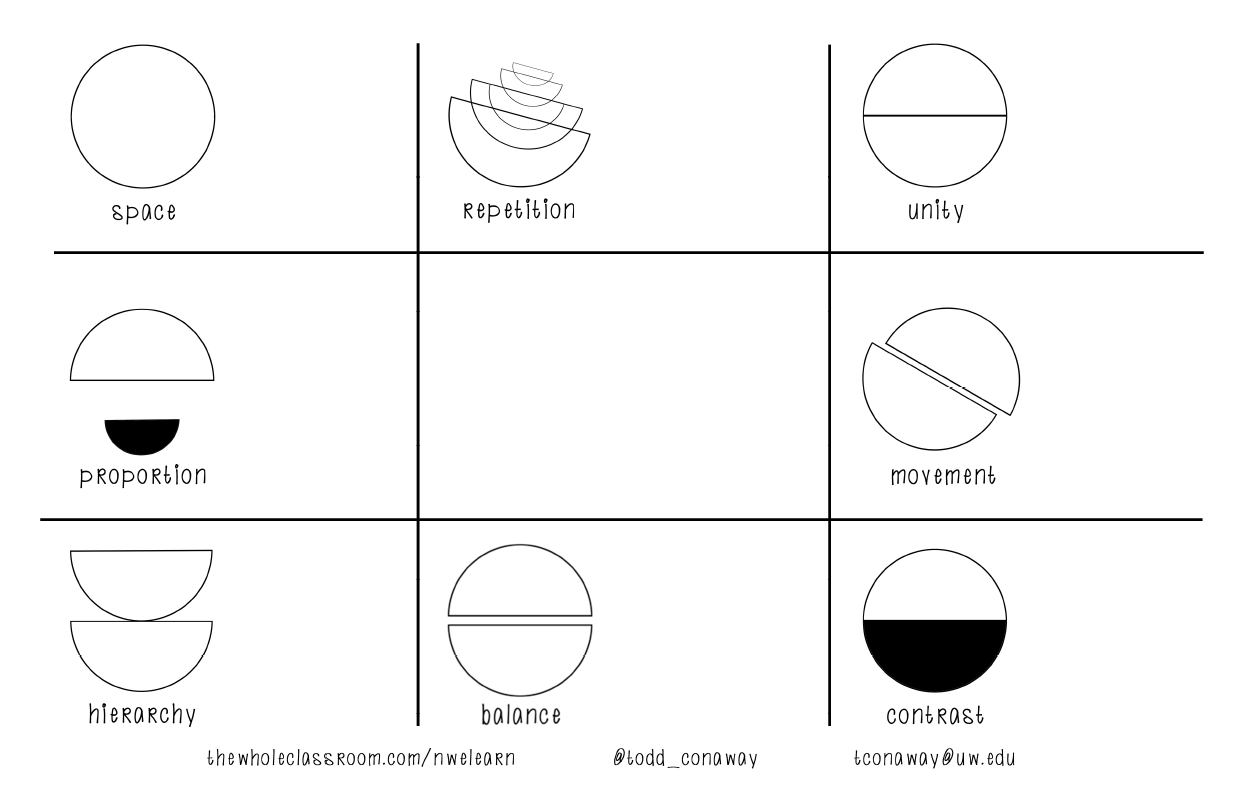
So that is why, “What’s my Line?”
For our purposes today, I’ll just point out that the Principles of Design and the Elements of Design are two different things. Roughly, the Elements of design are the tools used to make art. The Principles are how the elements are applied. For example, in a stick figure drawing, lines are used. Those lines may also be colored green. And the stick figure may be of a person. In this case, the elements of line, color, and form are used to create the representation of a person. Applying the Principles of design, we might make that green person larger compared to a smaller one. Here maybe we can say the tools are the tools of the trade of education. The software, The LMS, the chairs, the pencils. Even, “time.” How we choose to use them, or how we apply them, is our understanding of how we should be teaching. Or maybe our personal vision of pedagogy. The intentional practice of being an educator.
The intentional part is important. If teaching is an art, and that is how I see it, then we must be intentional in the design. Makes sense, right? But not being intentional, is seen from the student’s perspective as intentional. And that is where we have to work to place our point of view as that of a student. And further, as a good constructivist, I recognize that no matter how intentional my design, no matter how excellently I feel I have crafted an experience, it is up to the student to extract the experience and I cannot do that for them. This is where the intentional design of space may be present. Often, less direction, less “stuff” allows students to feel more space to create.
The principles of design have a long history that I know little about. I took a commercial art design class one time. I don’t really know what I remember from that class. But I do know how some of the principles connect to my work today and how I used them as a high school English teacher. Before we start, let me just give you a couple of quick examples. One of the principles of design is “pattern” or repetition. Most of us can see the application of that in the times we go to school and leave school. The days we give tests, or quizzes. Or the patterns of chairs and tables in our classrooms. So, there is one example. Another might be the understanding of “course flow” and how the work being done is spread through the semester, or a week, or a day. That might be tied to the principle of design, rhythm.

My only connection to this beautiful place, Bend, Oregon is my uncle. He was based here for many years as a helicopter pilot with the forest service. He directed the hot shot crews in the western US. He now lives in Ashland just south of there. I remember how he loved the cross-country skiing here and the beautiful natural landscapes. Now he lives in Ashland, Oregon, just south of Bend. He lives with his wife in a church. A beautifully restored church. He is the kind of person who lives very intentionally. Very aware. And he lives in a sacred space. It is a sacred space. The pews are gone, but most every weekend they host local artists and authors in their living room. It creates community. The place as a history of sacred space, but it is also actively turned into a sacred space each day. The times I have been there for a meal, they treat sitting down at a table together as sacred. The many faiths represented by artworks of all kinds in the space lend to an atmosphere is sacred. It is beautiful. I am lucky to have such a role model in my life. We visited them last summer.

Speaking of sanctuaries and churches, that brings me to my confluence of classrooms or educational activities and sacred space. I attended Prescott College, a small liberal arts school in Arizona. It was born out of the late sixties and some visionary educators. When I began my journey, the schools only building was a former Sisters of Mercy convent. Of course, it had a chapel. Many of my courses were held in a chapel. It is a wonderful world.
That brings us to a hint about my line, or my work. Space.

SPACE
When I walk into most any room, classrooms or living rooms, I always wonder, “why?” Why the colors? Why the window treatments, or lack of them. Fabric choices, arrangement, technology placement? Chair and table placement? Who will sit where and why? Who makes these choices and why? I think I love natural environments because I can wonder all I want about why stuff is the way it is and there are no answers. As a high school English teacher, one of the greatest lessons I learned was that there was the whole world outside my classroom and I could use it if I wanted. And I did. Whether it was a trip to a local bookstore, a trip to another state, backpacking in the Grand Canyon, or sitting under a tree just outside the classroom, I never let the walls of my room tell me how to teach. Ever.

I think we have more to learn about classroom management. About learning management. About where learning can take place. And one of the lessons may be about how to manage students or learning a little less. Giving students more control over their learning might produce more engaged learners and learners that believe they can make more changes.

You know Michael Franti? I only just discovered his music and shows two summers ago. I love his sound and his shows. There are kids everywhere and Franti spends at least half the show walking around in the audience and singing. He lets other people sing parts of the songs, he carries kids around while he sings. It is a really, really different FEELING than more “formal” rock concerts. My point here is that getting the audience/students into a place where they can be seen and heard provides us all with a better experience. It gives the students agency. It gives us all a moment to shine. Learning is participatory. Ask any constructivist. Learning needs emotions like fear and happiness. Learning needs challenges. You are the singer and songwriter. Let some others sing your songs and help you write the lyrics.
So, let’s take a look at this space we are in. Why is this here and that there. Well, if you have ever taught a class, given a workshop, or worked in a classroom, you’ll know some of this stuff. The lectern is always in the front. Sometimes, the screen covers up the whiteboard, and we don’t know why? The tables and chairs point this way or that way, and there are some windows. Hopefully, there are some windows.
I have worked long enough in this business to know a little about lecterns. They cost a fortune. They usually weigh a ton. Many of the pieces of technology in them are rarely used. The VHS player, the doc cam, the many pieces of software on the computer. Of course, someone does use them, just not most of the teachers who use the tools. And so they are big, and hard to move, and when you add a lecture capture camera, you often force the teacher to remain in one place as they present material. And here we are, where we are today.
And given my background with these things called lecterns, today I am going to introduce to you good people a new product I have just started to mass produce. You will be the first to see it in action, right here in this room. With this lectern. I know it will be a big hit among faculty who are disgruntled with the lack of aesthetic in modern classrooms. Even if you are stuck smiling for an hour into your lecture capture camera, it will help.
BRIEF PROMOTIONAL MESSAGE
I give you The Magic Lectern Enhancer™. In the box you’ll receive a C-clamp to hold the magic platform in place on any lectern and the magic platform which fits most makes and models of lecterns. Order today and you will receive a small houseplant with your order.

See how the plant adds some natural lines to an otherwise very rectangular and 90-degree angle environment. And it adds color. And it is good for the air in the room. And it gives you a sense of responsibility, as you have to care for it. You know, water it, and talk to it. When other faculty see that you have a Magic Lectern Enhancer they will know how committed you are to your workspace, and your students by creating an aesthetically pleasing environment for all of us.
The Magic Lectern Enhancer™ is of course, $9.99.
Well, that should be the end of all this, but it’s not.
You may have guessed, but I have no actual training in interior decorating. None at all. But I was high school English teacher for ten years and I do know that the way I shaped my classroom made a difference in what happened in it. It was the same principle at work as why after a few paragraphs of text, an image breaks the space and activity of a reader into something different. The way it looks and the way it is arranged has an impact. In the natural environment, there is no “decorating” or proper placement. Well, there might be, but it is likely some heavenly designer or some science I am unaware of.
In my work, I talk a lot about the design of things. The intentional design of things. So, for my time today, I thought I would draw some lines between the Principles of Design and our classroom experiences. And when I say classrooms, I don’t just mean the tables and chairs. I mean the whole classroom. You know, the one of the 21st century. The one that has colored chalk, dry erase markers, cell phones and the internet. The whole classroom.
Now, back to your regularly scheduled program.
REPETITION
And we are familiar with pattern in classrooms, right? All the exams and quizzes are on the last day of class. Or the homework is due at the beginning of each class. Or the classic, “reply to two classmates” in each discussion forum. These patterns in our courses are what become expectations for our students.
They help them as markers to navigate the course experiences.
For the last two years that I was a high school English teacher, we had 90-minute class periods. We had the longer classes for some time, but about two years before I left being a high school English teacher and started my current work, I bought about 500 dollars worth of drums and percussion instruments. For about two years I started each class I taught with 10 minutes of making music. More on that in a moment, but it was a really awesome way to begin a class.
I have been part of the ds106 class for several years. Alan Levine and others have been maintaining a space called the “Daily Create” which asks participants to complete a short work of art each day. I often start my day with this activity. It is better than answering emails. The Daily Create simply asks you to take 10 or 20 minutes to express. It is a warmup. Or perhaps, at mid-day, a healthy interruption.

How about personally? What activities do you repeat during the day? Mental or physical? Or both? Do you write about your work? Reflect on your work in words? On paper? Or the internet? I remember finding the amazing Stephen Downes. He said he was writing about a half an hour a day on a “blog.” I don’t think I even knew what that was at that time.
In classes, we might begin each class with “housekeeping” items. I always asked my Photoshop students if they had had any epiphanies during the week. It was wonderful to hear the students many variations, and often, what they shared was really valuable to their classmates. Often, the epiphanies were tips or tricks that may not have been covered in the class.

UNITY
Like I noted earlier, I was able to start each class period making music. I was fortunate to have small classes and that gave the students plenty of time to share ideas and expressions of learning. It is still a challenge to describe all the hows and whys of buying a bunch of drums and percussions instruments and starting every English class with them. I tried a few times. Below is one of them. All I know is it worked.
As a teacher, and the son of a family therapist, I know how important it is to just stop talking and let the students/clients do the talking. And as a drummer, I know how important it is to let the others have their time. Like jazz, we all should be heard. I remember really getting this deeply and in a sound thrashing from Marilyn Manson in the interview he did in Bowling for Columbine. He was asked what he would tell the students and his response was, “I wouldn’t say a single word to them I would listen to what they have to say.” That struck me in so many ways. Like the many people and ideas I have expressed in these first few moments of this project, it is all woven together, drumming and sound, English verbs and nouns, and heroes and songs. Why do we separate them so?
Where does unity live in the class? In the numbers of module in your LMS? In the book chapters? Sure. That is good. But in what other spaces might we find unifying moments of joy? Of empathy? Of what? And how will we know if we don’t get out there and experiment and take some risks? There was no way I could have anticipated what might happen playing drums in the English class! In 2011 I asked some of the students who had participated two questions about that experience. Here is what they said.

While teaching high school students, I also discovered what I believe was the most useful technological advance I have ever made. The discovery happened when I was looking for paper to refill the copier down the hall from my classroom. The shelf where the paper supply was usually kept was empty. So I thought I would steal some from another drawer in the machine. I opened the bottom drawer and there was this huge piece of paper! My first thought was, “Posters! I can make posters!”
I did that, but that was not the best thing I discovered. After finding that these large pieces of paper were exactly two 8 1/2 x 11 pages, I realized I could make newsletter type of publications. And that there was a thing called a saddle stitch stapler. After some experimentation, my classes were doing their writing and we made small magazine like publications. It is more fun when your classmates writing is included with your own.
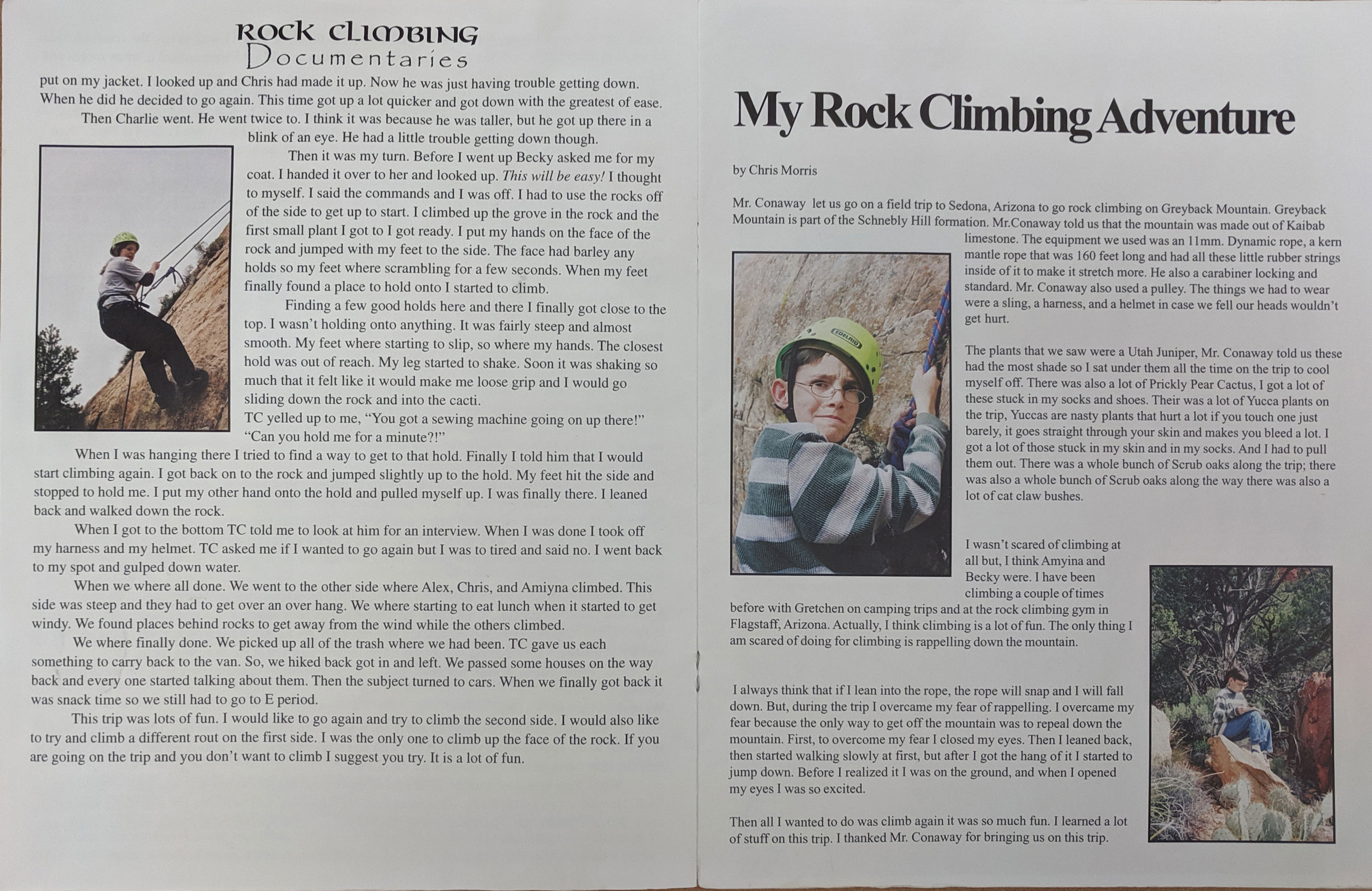
Bringing our class together around a shared adventure is important in creating unity. We can drum together. Write together. Or quietly reflect together. No matter the activity, a conversation about working as a team and accomplishing shared goals is important.
PROPORTION
I gave a talk a while back that really had me excited. I had a simple message: Easier is not always better.
I was going to look at that topic from the lens of working with faculty and their emerging digital literacies and skills. I have always been a Gallagher fan. You know, the comedian Gallagher. I am not sure about his work today, but in the old days, the smashing of things was pretty funny. I had this vision of smashing the notion of “easy” right out of sentences about learning and faculty development. And teaching online.
Along the way, I destroyed “efficiency” as it pertains to professional development as well. I feel good about that. At any rate, sometimes you just gotta go all out. Other times, you can relax.

Some faculty go a little further than others when it comes to acting. A favorite history teacher I worked worked with would role play Stalin and Socrates every year. He also dressed up as “condom man” for various school functions. I have not included those images here. While this might seem a little over-the-top for a college level class, I think that his efforts to convey a sense of time and place were admirable. His Stalin outfit was really impressive and he could tell you all about the jacket and hat. They had their own stories in history. For Socrates, he would get other faculty to participate in a mock trial.
Why is this important? There are variations in the texture of the class. There is the unexpected. There is drama. Laughter. Playfulness. That os why this is important.

Of course, not everything needs to be huge and on stage. Sometimes, something less than a minute is really useful. I created the weekly 57 Second Blackboard “Tip of the Week.” I thought I could do one each week for a long time. Turns our a long time is about five months. At least “every week.” I started skipping one here or there and before I knew it, I was skipping a lot of weeks. Kinda like New Year’s Resolutions. You really have to be committed. That is hard work. I did make 43 of them. Then we upgraded and many of the nice little videos become obsolete. They are small. They are consumable. That is good.
MOVEMENT/RHYTHM
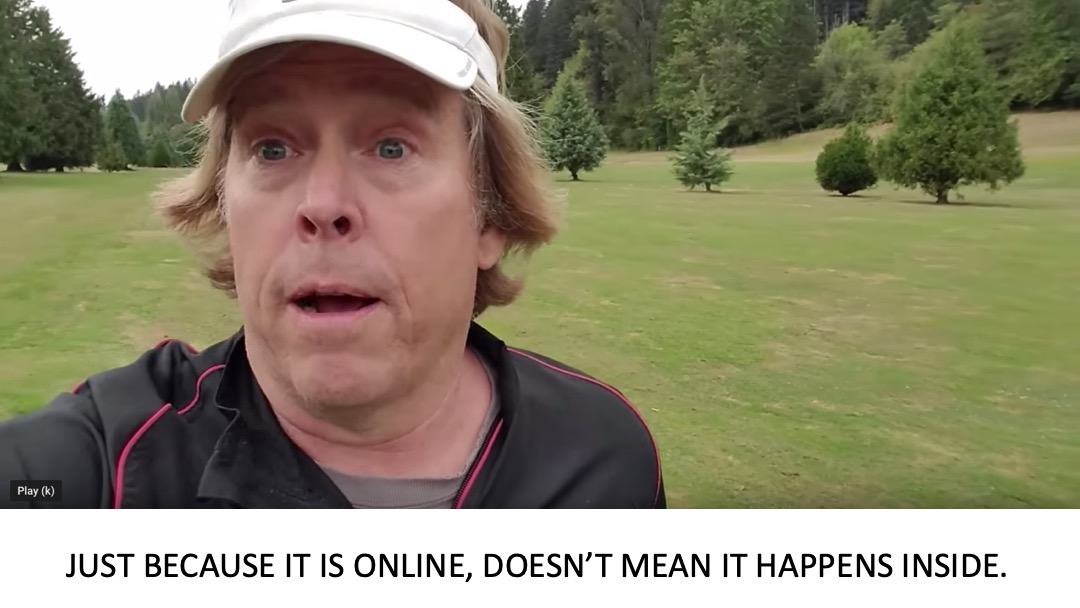
There is little worse than being trapped behind a podium. There is nothing worse than to willingly stand behind one for an hour. Well, maybe that is an exaggeration. But today our phones and the world outside is just waiting to be explored. Taking an online class does not mean you can’t get out there into the fair air and learn. Yes, you can still have field trips in online classes.
Does your class move? Does your work environment move? Do you create content that is created out in the open air? Outside? In the sunshine or snow? Well, you can even use the outside to convey informational messages to others. In bite sized pieces.
Often there is movement in classrooms. That is good.
My wife owned a dance studio for 20 years, teaching ballet mostly, but a lot of modern dance as well. I am pretty sure that from the first time I saw her, I understood that she danced her life. The first time I saw her she was talking to someone about 40 feet from me. What caught my attention was that she seemed to be trying to explain whatever she was saying through her whole body. Later, after I actually met her, I found that she was a dancer and choreographer. I have learned a lot about dance in the last 26 years. Perhaps the most intriguing to me was the life and work of Isadora Duncan. At the turn of the century she rebelled against the edges of the traditional dance culture. She also was an educator and she was a revolutionary. When I think of the educational landscape today, I most enjoy those who push against the sharp edges of the box.
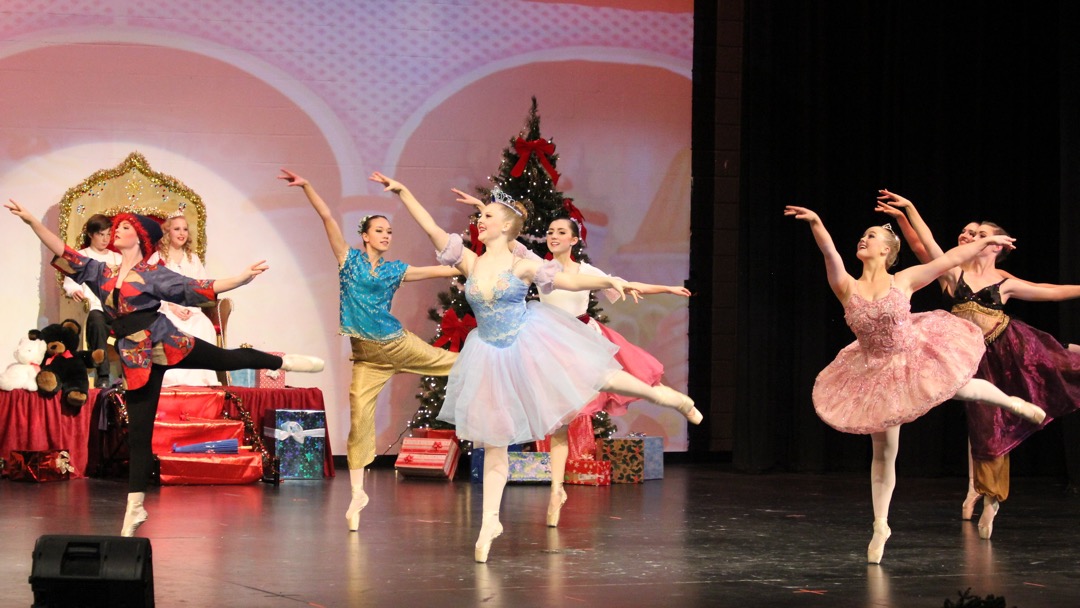
Over the years I have often used my experiences watching rehearsals and dance classes and found connections to the world of the classroom. I have gone as far as wondering if we can choreograph the time and space of the classroom. And, sure, we can. Dance often involves sound – we play music at the start of classes. You know, create a welcoming atmosphere. We can move tables and chairs around like props on a stage to make the space we have best enhance the experiences we may place our students around. We can use the talents and skills of various students to be leaders, or offer those with a bit less skill in some area to challenge themselves in particular roles.
Of course we can choreograph a classroom! We do it all the time. My question would be just how detailed are you in your choreography? What senses are you addressing, and why? When these questions move into the online space, how do these considerations apply? Can they make sequences better? Worse?
I have been taking yoga classes for a couple of years. A few months ago, after a particularly wonderful class, I spoke with the teacher who I had been taking classes with pretty regularly. The class had a different feel to it and I knew that she really thought about the class sequences and had clearly been teaching a long time. As we talked I we wondered about the types of songs played and the order they were in. We wondered about spaces for rest, and for how long. She teaches mostly vinyasa classes so they are pretty energetic. We talked about the start and stop of music and types of music. I realized it was all the same. English classroom or yoga class or a ballet. There are all these disparate elements that need to be crafted into a whole experience. That is the craft of teaching. The art of teaching.
HIERARCHY
There is a clear hierarchy in classrooms. It is usually most visible in the layout of classrooms. But there are options. Sitting in circles and passing the conch shell, sitting in small groups. You know. You have seen these things happen in various classrooms. Perhaps you work in an open space like I do. It used to be cubicle land. Now it is open and we can talk with one another more freely.
You can intentionally remove some of the less helpful parts of hierarchy by allowing students to create course content. The amazing Robin DeRosa had students in an early American literature course create an anthology. It could be a set of Quizlet practice sets that students make. It could be an annotated bibliography on a LMS page. It could be an open syllabus on a Google doc.
How much of the content in your course is student generated? How is their work presented? And who is the audience?
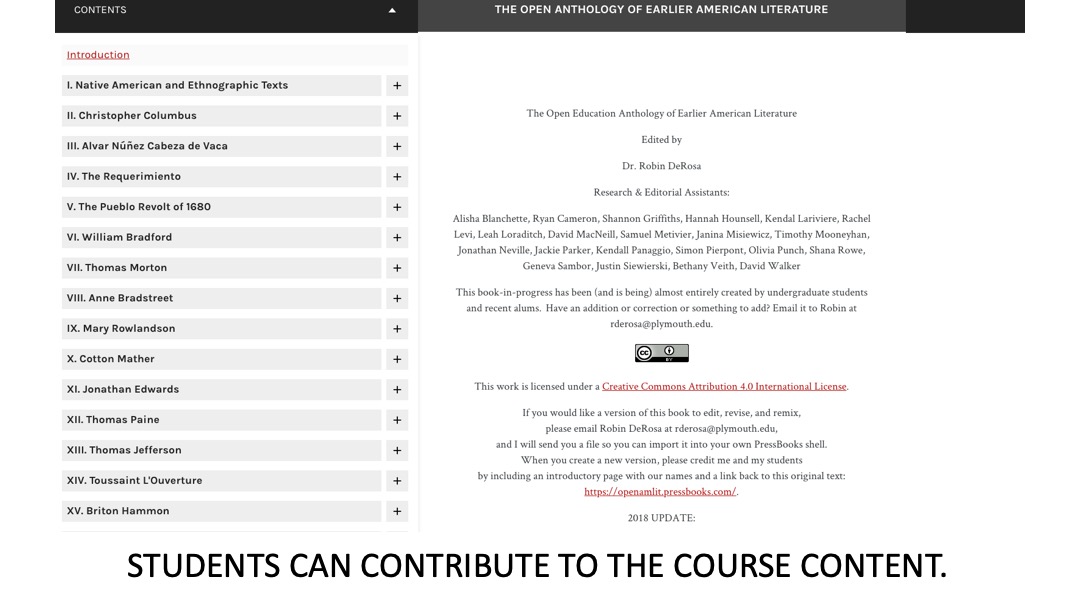
Last summer, Mike Wesch created a beautiful course out there on the internet titled, Anth101. He changes up the language we have used for years in the world of schooling, he alters “assignments” to “challenges.” He takes a deep dive into allowing student stories and student experiences drive much of the conversation and the content and structure of the course.
And like he asks of his students, he shares the work he has created with us. How do you share the work you create? Do you have a YouTube channel? Are some of your teaching materials available to other educators whoo may benefit from them? our training materials. Your presentations like this one 🙂
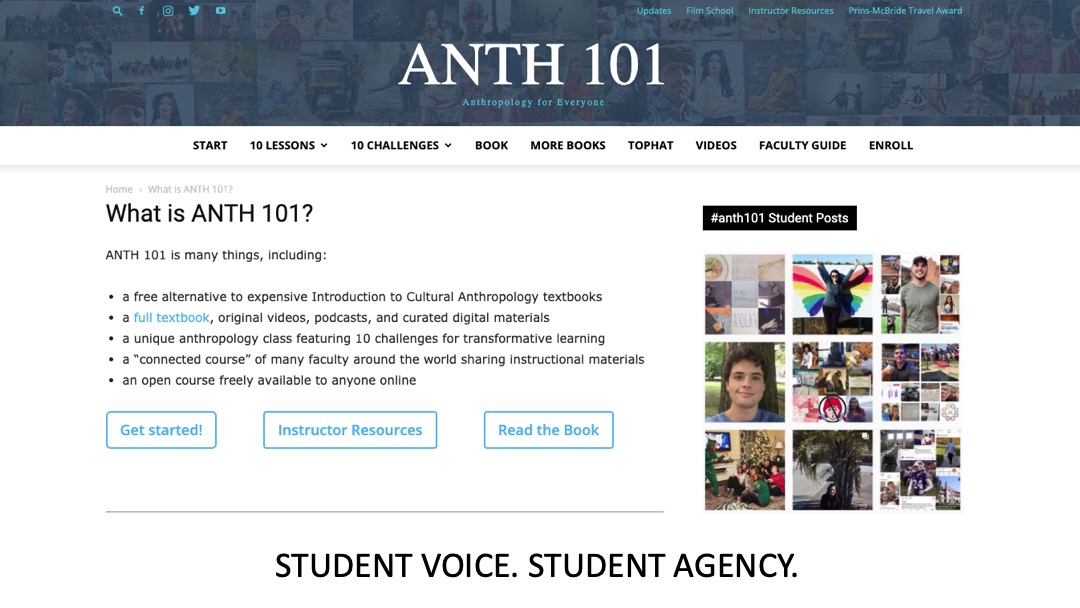
You can give students a voice and you can give faculty a voice. You can give your team a voice. My team here in Washington is trying to find our collective voice. It is a process.
In the examples above we see the role of students being elevated and their work shared as meaningful learning opportunities. But I have used a similar strategy for faculty. Getting faculty to share their ideas about teaching and online practices is hard work. There is resistance from a number of angles. technical challenges. Fear of unknown audiences. The classic, “I don’t do anything special.”
But they will share. In fact, my team got our faculty to share hundreds of blog posts and pages of writing about teaching. And they do it every year! So do some other colleges. We also got them to make short videos about teaching online. So did some other colleges 🙂
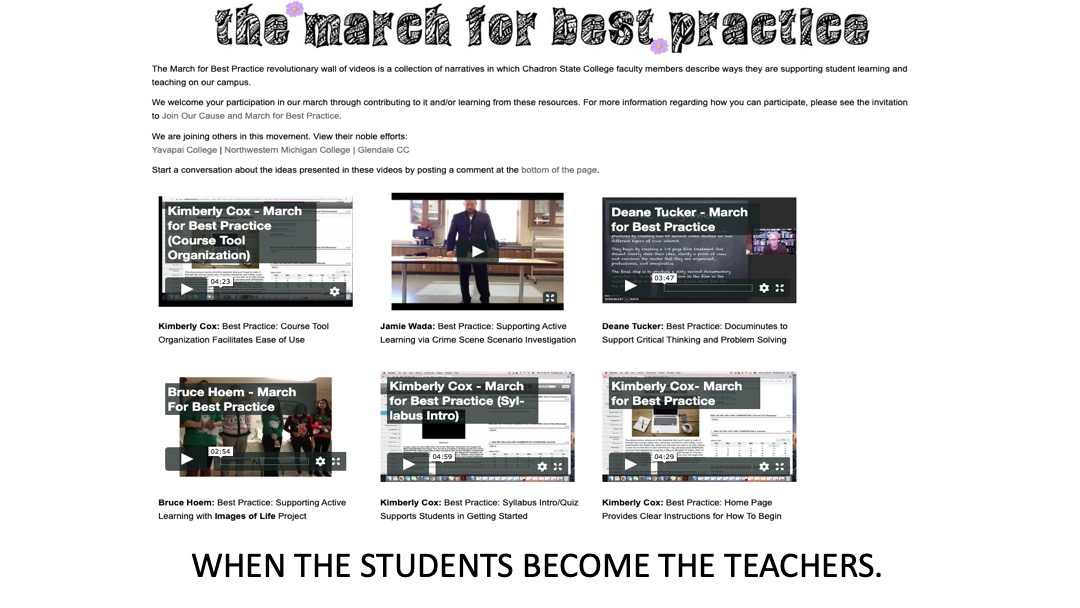
BALANCE
Sometimes I wonder if the “box” we always hear about in education is the 8 1/2 x 11 piece of lined paper. And maybe the most traditional forms of written expression. The paper certainly serves a purpose. It will fit in a binder that will fit in a backpack that will fit on your back. That is good. I don’t want to walk into the weeds of academic writing and creative expression, but I feel we have sometimes sacrifices the latter for the former. Of course, I prefer poetry over technical writing. That is my preference. I value both, but I learn better when emotions are present. We all do.
These days we have so many beautiful was to express learning. Students can create videos that reflect their learning. Audio clips, websites and other digital art. Where is the balance of expression in your class? In your work? How are you able to reach different audiences with the variations in your expressions. We are looking for multi-sensory experiences that ask students to share their learning with real life and varied audiences. In my work I try hard to share what I learn and know in a variety of places and for a variety of audiences.
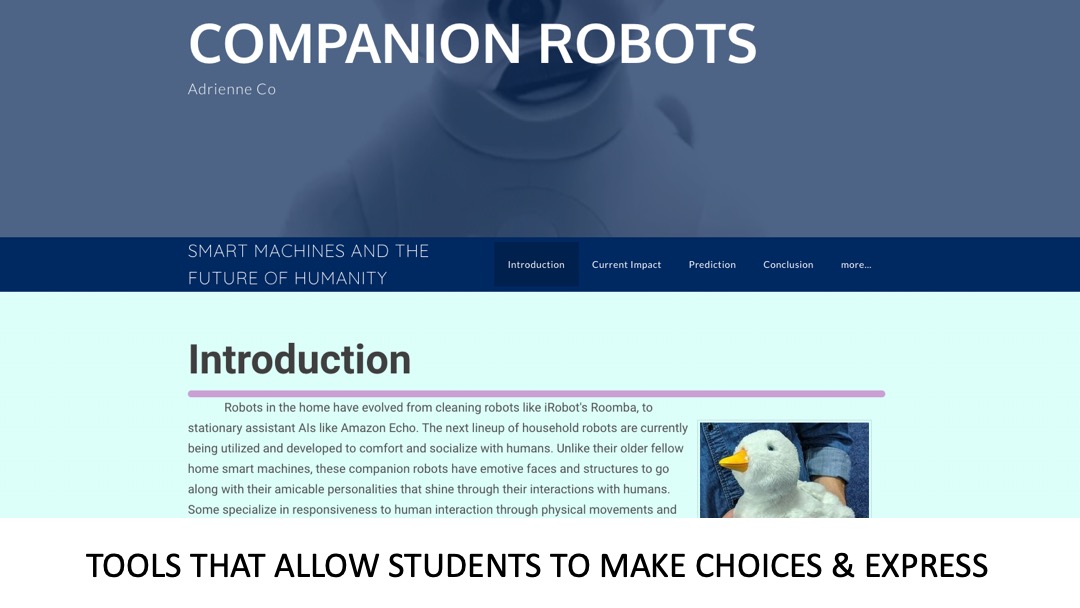
Balancing can be seen in many places in a classroom, or syllabus. Is there a balance of language? Of kinds of assignments? of types of reading? From authors from varied backgrounds and beliefs? Heck, are there varied types of questions on the quizzes is a simple place to make progress in finding more balance.
If you play music durning class, is it varied? Do you always lecture for 50 minutes? If so, with what is that balanced? To you balance the sitting with movement?
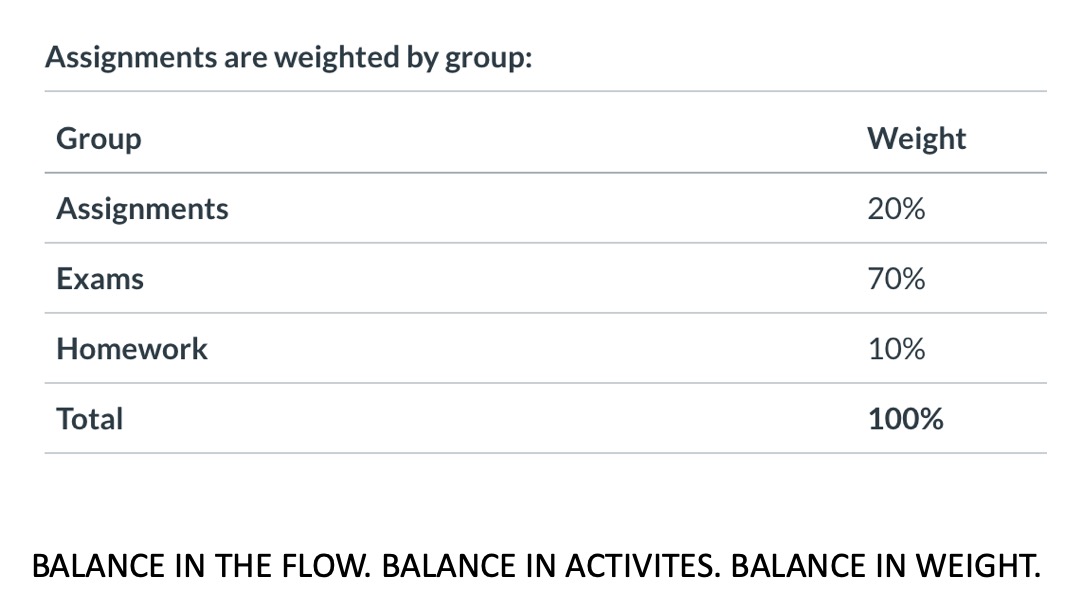
Finding the right balance of spices when cooking a meal is not dissimilar from adding the right activities, with the right tone, the right length, and stirring some of the right emotions into a classroom activity. And even when little thought is given to the feelings and emotions of the students in the room, for them, it is visible and it exists. Isn’t this part of the challenge? To see the work we do from the eyes of those that experience it. To listen to them and ask for feedback.
Higher ed is full of silos. Or so they say. Sharing our work, both successes and failures is really important to a “learning organization.” Back in Arizona, we revised the 9x9x25 Challenge this year to focus on writing a faculty handbook. Not a handbook of policy and rules. But one written by faculty, for faculty, and it focuses on “What I wish I would have known my first year of teaching.”
CONTRAST
I was able to generate a lot of effort and support for teaching and learning from college faculty just by giving them some fun items along with some more “academic” rewards. I gave them ice cream. I gave them books about teaching. I gave them plants and I gave them subscriptions to “The Teaching Professor.” I am not sure if it was just the idea of being given a pint of Ben and Jerry’s ice cream for doing some writing, but some of the faculty really wrote some great stuff!
Not everything is about pay increases and tenure or promotion. Sometimes a simple handwritten note will inspire people to go way beyond what they might normally do.
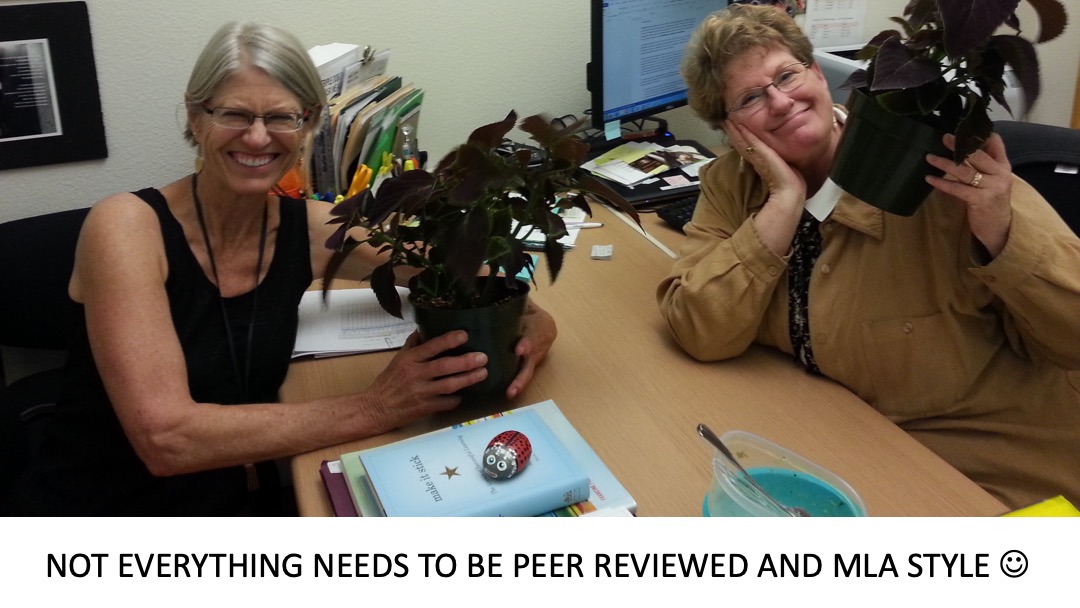
Have you ever given crayons to a group of R1 university professors as part of a teaching and learning professional development event. Well, I have. They both laughed, and learned. The whole program was a coloring book. The site we used for some of the resources was very similar. How much joy is in the room? Do you intentionally place joyous opportunities in your work or classroom? Do you take the work too seriously? Is that possible?
Are we finding balance between the contrasts of lofty academic challenges and playful moments that may allow for more free and creative associations. And perhaps more enjoyment of the work we do.
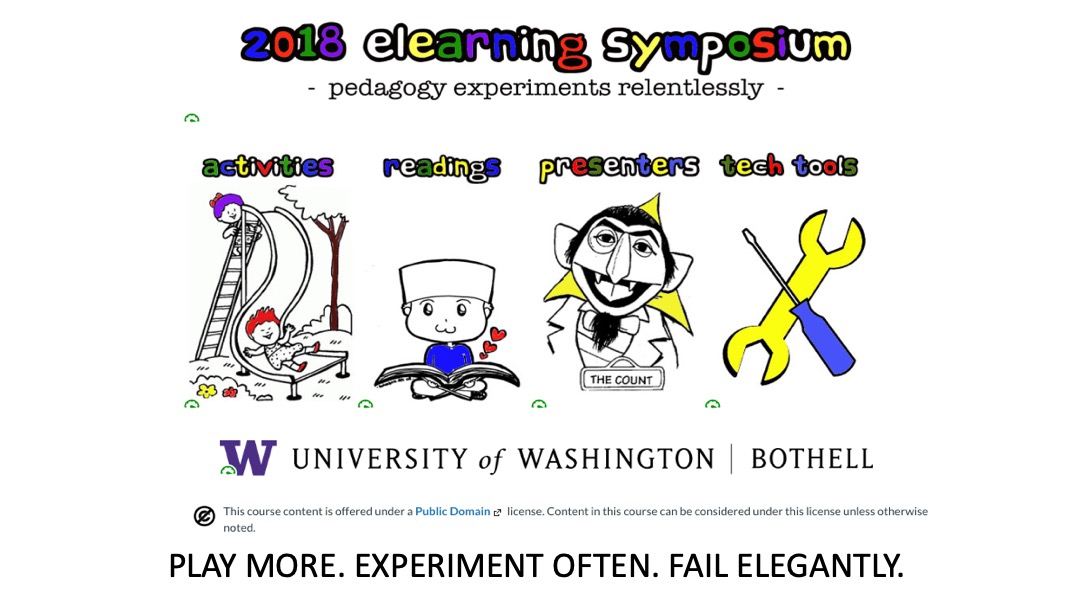
I think that there is much to learn in play and it is often underutilized in classroom spaces. And I don’t mean just playing games. Opening up to the possibility of serendipitous events, creating a space where connection between seemingly disparate ideas and content can happen. That is opening up to playful spaces.
Now we come to the end of these stories. These loose connections between the principles of design and the way we work or how we see our classes. I will leave us with a Micheal Franti line I saw on a picture of him once. One he often wears on a shirt.
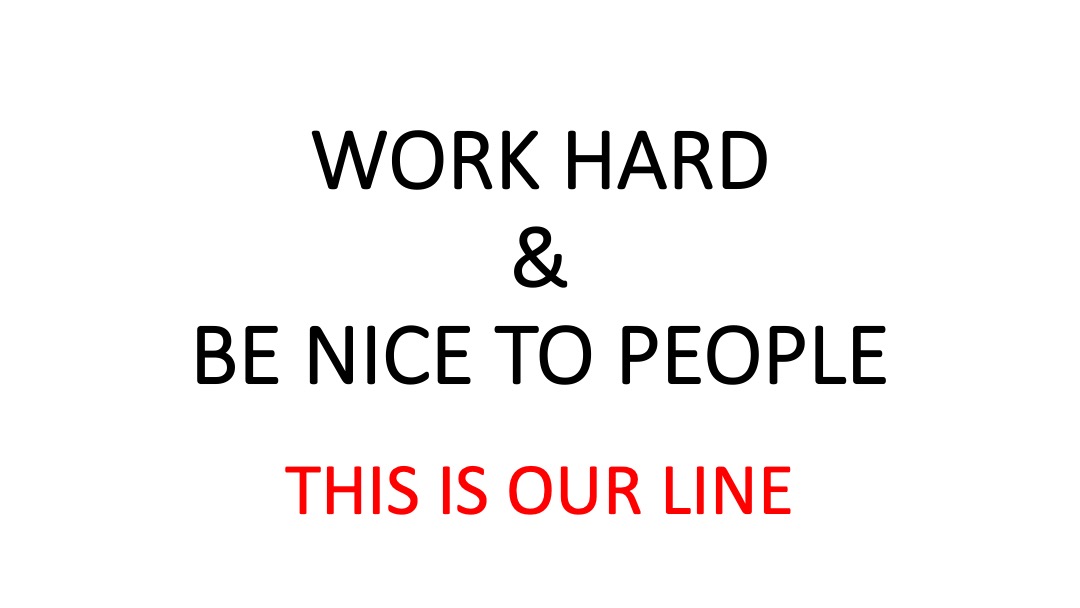 This seems very pertinent these days. There is a lot of anxiety out there about stability and technology. Of work and the challenges of modern schooling. Budgets. Leadership. Lots of things to worry us. We can focus and work hard. And we certainly can be nice to people.
This seems very pertinent these days. There is a lot of anxiety out there about stability and technology. Of work and the challenges of modern schooling. Budgets. Leadership. Lots of things to worry us. We can focus and work hard. And we certainly can be nice to people.
This work I do is about trust. Being helpful. Being nice. I work hard at those three things.